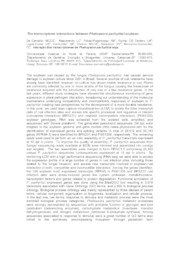The transcriptome interactions between Phakopsora pachykopsora pachyrhizi-soybean.
The transcriptome interactions between Phakopsora pachykopsora pachyrhizi-soybean.
Author(s): CARVALHO, M. C. C. G. de; NASCIMENTO, L. C.; POLIZEL-PODANOSQUI, A. M.; ROCHA, C. S.; DARBEN, L. M.; LOPES-CAITAR, V. S.; CARAZZOLLE, M. F.; OLIVEIRA, M. L. C. S.; ABDELNOOR, R. V.; MARCELINO-GUIMARÃES, F. C.
Summary: The soybean rust caused by the fungus Phakopsora pachyrhizi, has caused serious damage to soybean culture since 2001 in Brazil. Several sources of rust resistance have already been identified; however no cultivar has shown stable resistance to rust. Plants are commonly infected by one or more strains of the fungus causing the breakdown of resistance acquired with the introduction of only one or a few resistance genes. In the last years, different study strategies have allowed the simultaneous monitoring of gene expression in plant-pathogen interaction, broadening our understanding of the molecular mechanisms underlying compatibility and incompatibility responses of soybean to P. pachyrhizi creating new perspectives for the development of a more durable resistance. In this work, we used laser capture microdissection (LCM) to isolate the foliar mesophyll cells of rust infection sites and access site specific processes and regulators in tolerant (compatible interaction) (BRS231) and resistant (incompatible interaction) (PI561356) soybean genotypes. RNA was extracted from the isolated cells, amplified, and sequenced with Solexa plataform. The generated paired-end sequences (54 bp) were mapped to the soybean genome and gene models (http://www.phytozome.net) for the identification of expressed genes and splicing variants. A total of 28,572 and 30,743 genes (RPKM>3) were identified for BRS231 and PI561356, respectively. The remaining reads were used to perform an ab initio assembly of P. pachyrhizi transcripts expressed at 10 dpi in planta. To improve the quality of assembly, P. pachyrhizi sequences from Sanger sequencing reads available at NCBI were trimmed and assembled into contigs and singlets. The two assemblies were merged to form PPGC1.0 comprising 36,350 unique P. pachyrhizi sequences (unisequences) expressed at 10 dpi in planta. By combining LCM with a high performance sequencing (RNA-seq) we were able to access the expression profile of a large number of genes in rust infection sites, including those related to the fungal invasion, and access new transcripts involved in soybean-rust interaction in both, compatible and incompatible interaction. Among the genes identified, the 100 soybean most expressed transcripts (RPKM) in PI561356 and BRS231 rust infection sites were stress-induced genes like cystein proteases, metallothioneins, transcription factors and genes related to protein degradation. Functional annotation of P. pachyrhizi expressed genes was done using the Blast2GO tool resulting in 3,976 transcripts associated with Gene Ontology (GO) terms, and 2,902 to biological process ontology. Biological process ontology was mainly represented by three classes of parent terms: cellular component organization or biogenesis, localization and cellular process. In the last one, two terms: response to stimulus and metabolic process were the most enriched biological process categories. Phakopsora pachyrhizi metabolic processes were strongly represented by sequences with probable function in glycogen and lipid catabolism (debranching enzymes), carbohydrate metabolism (invertases, mannitol dehydrogenases) and nitrogen metabolism (trehalose 6-phosphate synthase). Among sequences associated to response to stimulus were a great number of GO terms also linked to the symbiosis, encompassing mutualism through parasitism term (GO:0044403) including proteins involved in nucleotide binding and DNA metabolic process (nucleases and response to DNA damage stimulus), thiamin metabolic process, proteolysis, response to reactive oxygen species, GTPase mediated signal transduction, inositol-lipid mediated signaling and calmodulin signaling. Using a combination of approaches based on Blast similarities against local databases and an initio prediction, we generated a list of 905 putative secreted proteins from the total of 36,350 unique P. pachyrhizi unisequences. To identify a set of candidate P. pachyrhizi effectors, we grouped the predicted secretome into tribes or families to find those unisequences associated to expanded families. Of the 100 tribes formed, 50 of them contained more than three unisequences. A list of the 169 unisequences were obtained, that combine defining features to be common between effectors, such as small open reading frame ORF size (<250aa), no intracellular function described, enrichement of cystein residues (>3%), and presence of the previously described Y/F/WxC motif. These characteristics are mostly observed among the members of tribes 1, 2 and 17. A temporal expression of 58 candidate effector genes was characterized from spores, germinated spores and infected soybean leaves at 0, 6, 12, 24, 36, 48, 72, 96, 192 and 240 hours after inoculation (hai) using RT-qPCR. Expression analysis showed differential temporal gene expression of these candidate effectors. Heat map analysis revealed three main clusters with coordinated expression of candidates across the infection cycle. The first has candidates exp
Publication year: 2014
Types of publication: Abstract in annals or event proceedings
Unit: Embrapa Soybean
Keywords: Doença de Planta, Ferrugem, Plant diseases and disorders, Soja, Soybean rust, Soybeans
Observation
Some of Embrapa's publications are published as ePub files. To read them, use or download one of the following free software options to your computer or mobile device. Android: Google Play Books; IOS: iBooks; Windows and Linux: Calibre.
Access other publications
Access the Agricultural Research Database (BDPA) to consult Embrapa's full library collection and records.
Visit Embrapa Bookstore to purchase books and other publications sold by Embrapa.

